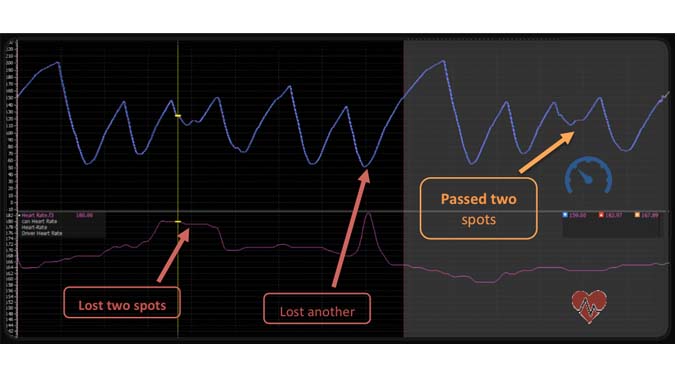A couple of months ago I introduced you to Chris Blomfield-Brown, of Wireless Motorsport. He wrote about the importance of monitoring your heart rate when driving. This week, he’s back with more on a topic that I find both fascinating and very useful.
Useful? Yes, by monitoring your heart rate, you can learn all sorts of things that will improve your driving performance.
Learn more and enjoy! — Ross
We have been observing drivers’ biometric data and discovering some enlightening trends. Biometrics refers to technologies that measure and analyze human body characteristics. In this case, monitoring a driver’s heart rate integrated into the data acquisition system using BioTelemetry gives us a clearer picture into the driver’s involuntary biometric responses. Monitoring the heart rate not only tells us the cardiovascular effort exerted while driving, but the body’s involuntary response to different situations.
To be clear, driving a racing car is an athletic endeavor. Monitoring a driver’s heart rate and body temperature shows that most forms of racing can be the cardiovascular equivalent of running competitively. One should not underestimate the fitness required to compete competitively. There has been a lot of research to show that fatigue, mental stress, and heat stress have a negative impact on performance. Humans are very good at compensating, so we are unaware of the effects of things such as fatigue until they are at extremes. It’s similar to the consumption of alcohol; only once we have excessive amounts in our bodies are we aware of its effects (and then some of us still are not too sure!).
Monitoring the driver’s heart rate can do more than show physical effort; it can also show stress, fatigue, and a driver operating outside their normal parameters, indicating there may be an external influence affecting performance.
A small amount of stress can be beneficial. When we are under limited stress, we become very aware of our situation, our senses are heightened and we can be very focused. Some may refer to this state as "being in the zone." Too much stress can be detrimental – this is when we become reactive. When we are in a reactive mode, we make split-second subconscious decisions, with the outcome having only a marginal probability that the optimal decision is made.
In the following graph, we have a speed and heart rate trace. The spike in heart rate occurred when the driver came under pressure and shortly afterwards made a mistake, letting two cars pass. Still stressed, he let another car past; the quick change in heart rate indicates the driver operating in a high stress state. What you won’t see is the driver calmed down and passing two cars the following lap. The stress contributed to the driver making a mistake.
What causes stress is very driver-dependent. Often you will see stress levels go up for most drivers in a high-speed scary corner, but other situations will affect many drivers in a completely different way. Some examples of situations we have observed: qualifying, race weekends, rain, and traffic in practice. One driver had issues on restarts, so would be very stressed under the safety car, which is something we never expected to find.
So once you identify what’s causing the stress, what can you do about it? For most situations, you can try very simple methods to lower your stress levels. For example, we observed a driver who missed a gear change from 2nd to 3rd. As a result, their stress levels rose whenever they needed to change from 2nd to 3rd again. So when you are stressed or worried about missing a gear, you may be tensing up your shoulders and neck, tightening your grip on the gear lever, holding your breath – making your stress trigger a self-fulfilling prophecy. Once you are aware of this situation, consciously relax your shoulders, open palm the gearshift, and take a deep breath before doing the change and you will find you will have much better results.
Stress triggers can also be caused by a section of a circuit where you’re experiencing difficulty or lack confidence. This could be from the car handling setup issue or possibly a difficult brake marker or missing the ideal line. The following track map has the biometric data highlighting the problem area.
For a section of a circuit that is causing difficulties and increased stress it often can be resolved with simple solutions such as: better visual reference points, an exact braking marker or watching video to see the proper lines through the corner.
Increased stress can also be a reflection of an unbalanced or poor-handling car. An unbalanced car can cause increased stress and may help clarify driver feedback. Remember that a driver needs confidence in how the car will react and when they lack this confidence we often see increased stress. So addressing the car balance and making the car faster can also help reduce driver stress.
There are many different situations and circumstances that can increase driver stress and many possible solutions for either lowering stress or better ways to handle those situations. The important first step in making a driver faster by limiting the effects of stress is to identify what is causing increased stress.
A race car is a complex system with the largest variable being the driver. Biometrics can be another important piece in solving the puzzle, giving us insight into optimizing the driver.
Says Matt Romanowski, driver training and data acquisition guy (and Speed Secrets Weekly contributor) at www.trailbrake.net: "For years we have monitored every part of the vehicle possible – every part except for the most critical component – the driver."
– Chris Blomfield-Brown




















